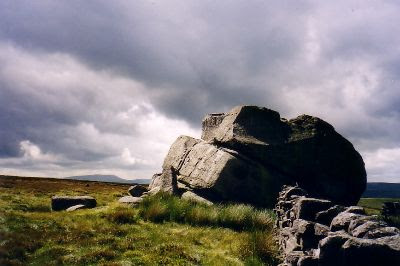A few years ago I had the good fortune to chat with Arthur Hopwood, a resident of Meanwood in Leeds and a diligent researcher of all things local and historical. He told me of a rumour that he'd heard concerning a curious rock carving to be found in some nearby woods at Adel, a suburb on the northern edge of Leeds. He didn’t know any details, but he seemed to recall hearing about it from the Meanwood Valley Countryside Ranger. Several months later I had a chance meeting with the Ranger, Elaine Hill, as she was working in a local park. She graciously offered to show me the carving the same afternoon.
It’s very indistinct, if she hadn’t pointed it out and traced the outline with her finger, I doubt I’d have known it was there at all. Apparently, it was discovered by a local woman whilst out walking her dog. The woman had noticed it several years previously and eventually thought it curious enough to bring it to the attention of English Heritage.
Elaine sent me a copy of the English Heritage Inspector’s report, which said:-
“The carving depicts a schematic image of a human figure in a style typical of the Brigantes tribal region. The carving is difficult to date, but the depiction of a circular shield is characteristic of early Roman images. The figure has been identified as a Celtic warrior god Cocidius, a deity which features regularly in Romano-British society. The figure is approximately 40 cm high, with a sub-circular head, almost square body and disproportionately long arms and legs. The legs are not clearly defined and the right side of the figure is either more eroded, or was carved less-deeply than the left. The facial features of the figure are barely discernible but the eyes are set close together and positioned high on the face above a long nose. These types of features are typical of the Celtic portrayal of the human figure. Two concentric circles extending from the left hand are understood to be a shield, and carved linear forms extending from the right hand are interpreted as a spear or sword.
It is unclear why this carving is located here as there are no contemporary monuments or features in the immediate area, although the Roman fort and settlement at Adel lies only 1km to the north west. Comparable examples elsewhere in the country (which are few in number) have been interpreted as shrines or burial markers, but in this case there is no indication where any burial may have lain.
The rock carved human figure… is the only example of Romano-British rock carving known in West Yorkshire and one of very few known outside the frontier region of Northern England… The carving provides a very important contribution to the knowledge and understanding of Celtic art and religion in this area and in the wider landscape.”
A friend put me in touch with Nick Ford, currently working on the definitive reference work on native gods and goddesses of Roman Britain. Intrigued by the carving, I asked him for a little information regarding this deity. He told me;-
“Most, if not all, inscriptions seem to be by military personnel and (with one exception, in Lancaster) from the central area of the Wall, and north and south between Redesdale and Derwentdale. Some inscriptions conflate him with Silvanus, some with Mars. Once also with Vernostonus, who is unrecorded elsewhere to the best of my knowledge and who I take to be a god imported (as it were) by Germanic, Tungrian or Frisian auxiliaries. Silvanus is your Roman god of the wild places (especially woodland), and frequently invoked here and elsewhere when hunting (a major occupation by soldiers stationed in this military zone). But then, Mars is similarly invoked sometimes. A crude silver plaque found there shows him with spear and shield, and for no better reason than this he has, like Belatucadrus a little further southwest, been defined as a 'war god'. Just as they might have done with Minerva, if she hadn't a huge literary tradition describing her many other abilities and interests. The fort at Bewcastle was apparently known as 'Fanum Cocidi' ('The Shrine of Cocidius'), and there are more inscriptions to him there than anywhere else. But was his shrine there before the building of the fort? I would suspect so, and that he is therefore a local god.
The etymology of the name seems Celtic (tentatively, I'd translate it as 'The Red God'), but half the Roman army on the Wall spoke a Celtic language, so it's possible he came to Britain with some military unit or other. Don't rule out the possibility, either, that Cocidius may be another British god under another name in another place. For what it's worth, though, my feeling is that he is himself and no-one else, and he is local to that area.”
However, Mr. Ford did wonder why it has been identified so confidently as Cocidius. Especially as the carving is indistinct and the location of the stone is not in the area in which there is supporting evidence for his cult...
And another thing!
Marion Benham pointed out the uncanny similarity between the Cocidius carving at Adel and the 'Devil Stone'; a 'sheela-na-gig' carving said to be of Romano-British origin, in St. Michael's church at Copgrove in North Yorkshire.

Weird, eh?......









































